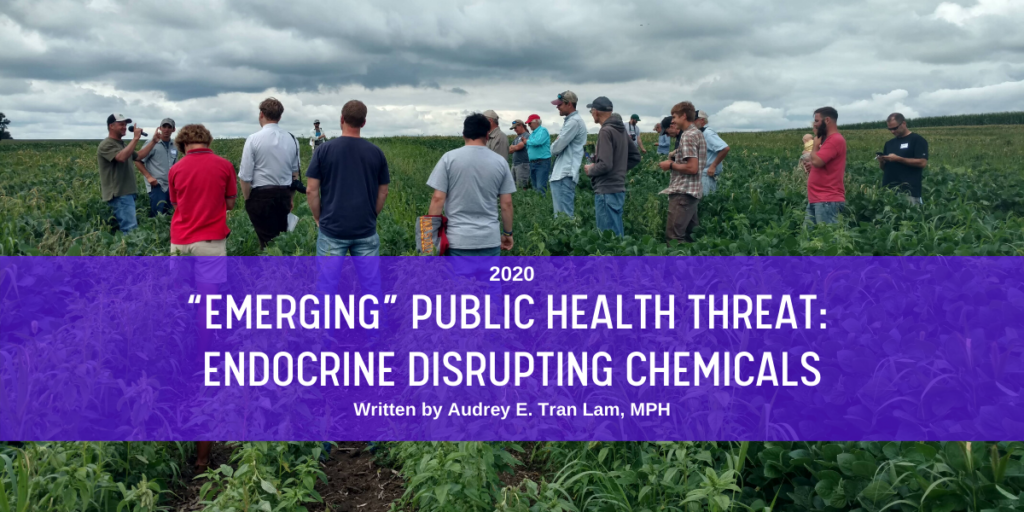“Emerging” Public Health Threat: Endocrine Disrupting Chemicals

By: Audrey E. Tran Lam, MPH
During all of the downtime I’ve recently discovered in the face of this global pandemic, I’ve finally finished the book Our Stolen Future, written by Theo Colburn, Dianne Dumanoski, and John Peterson Myers back in 1997. The topic of endocrine disrupting (or, hormonally active) chemicals has been on my radar since I started my work at the Center for Energy & Environmental Education, but Our Stolen Future helped ground many of my concerns with a “fresh” perspective. Some of you may have heard of a book more recently published by Dr. Leonardo Trasande, Sicker, Fatter, Poorer, which has been touted as the modern retelling of the Endocrine Disrupting story. Endocrine disrupting chemicals (EDCs) have been labeled an “emerging” public health threat, despite the clear warning signs we had about them back in the 90’s.
My professional background is in chemical exposure and human health, a pillar of environmental health. Some people think “environmental health” refers to “ecological sustainability,” but actually refers to a branch of public health dealing with factors in the environment that affect human health and disease. It’s a broad category in public health, and a tricky one to work in sometimes; environmental health is murky. There are so many factors and variables in our environment that contribute to disease—how do we tease apart cause and effect of exposure and disease in an individual’s life? How might we uncover whether someone’s cancer, diabetes, or other chronic disease is caused by exposure to a certain chemical (or combination of chemicals), when other factors (like diet and exercise, family history, and individual practices and behaviors) could be playing as much of a role?
Endocrine Disrupting Chemicals
Endocrine disrupting chemicals add another layer of complexity to an already complicated environmental health picture. Hormones are chemical messengers that are responsible for nearly all the healthy functioning of our bodies. EDCs are chemicals that mimic our own endogenous hormones – that is, hormones that we’re supposed to produce in our bodies.
Taken from the Endocrine Society’s website, “EDCs can disrupt many different hormones, which is why they have been linked to numerous adverse human health outcomes including alterations in sperm quality and fertility, abnormalities in sex organs, endometriosis, early puberty, altered nervous system function, immune function, certain cancers, respiratory problems, metabolic issues, diabetes, obesity, cardiovascular problems, growth, neurological and learning disabilities, and more.” Children are the most vulnerable to the harm that EDCs can cause, and their effects are felt throughout an affected child’s lifetime.
Toxic chemical exposure is often implicated in direct DNA damage and mutation. When we think about toxins in our environment, the first thing we think about (or, at least it’s the first thing I think about) is cancer. The thing about endocrine disrupting chemicals is that their influence goes beyond cancer. While this class of chemicals have been implicated in cancer development itself, they also can negatively impact many of our bodies’ metabolic processing and reproductive functioning. How does cancer risk increase in a young girl who, after low-level exposure to EDC’s, starts puberty early and expands her window of estrogen exposure over her lifetime? How does cancer risk change as the number of obesogens (a type of EDC that does exactly what it sounds like) increase our chances of being overweight? While there’s still a lot to learn about these chemicals – teasing apart the myriad variables I mentioned before – we’ve been assembling a constellation of evidence that tells us we should proceed with caution regarding endocrine disruption.
Eliminating EDCs
When it comes to cancer and toxins in our environment there’s a lot of emphasis on exposures that individuals can minimize. “Stop smoking” or “get your house tested for radon” are things individuals might hear. But how many of us have heard of eliminating pesticide use in and around homes, to limit our food’s contact with plastics, or to scrutinize the labels on our cosmetics for phthalates (all sources of EDCs in our immediate environment)?
Other common culprits of EDCs in our immediate environment are flame retardants, PCBs, perfluorinated chemicals (or PFAS), BPA (and other bisphenol chemicals: BPS, BPF, etc…), and parabens. Checking labels of personal care products for some of these ingredients, as well as avoiding plastic – especially those numbered 3, 6, and 7 – and pesticides can help reduce your everyday exposure.
Here are some additional tips to limit your exposure at home:
- Swap out plastic Tupperware for glass or metal (but try to avoid aluminum); be especially careful to remove plastics numbered 3, 6, and 7. Never microwave plastic Tupperware, or put it in the dishwasher, regardless of its number. Recycle it if it becomes scratched or cloudy.
- For personal care products, check out the Environmental Working Group’s Skin Deep database. There you can sort products by harmful ingredients to know what to avoid the next time you restock your bathroom.
- Buy fresh, local, and organic produce. Creating consumer demand for Iowa grown fruits and vegetables supports biodiversity in Midwestern agriculture and will help to reduce everyone’s background exposure to pesticides.
- Remove or replace old furniture (especially ones with bits of foam poking through the fabric)–check the fabric content for flame retardants.
- Download the Detox Me app to learn more about common household exposures of Endocrine Disrupting chemicals and other household environmental hazards.
- Use herbicides or insecticides on your lawn? Stop! This is a very avoidable source of EDCs and other harmful chemicals to which children and pets are inherently vulnerable. Learn more about natural lawn care at Good Neighbor Iowa.
This is by no means an exhaustive list. Individual action can only go so far to reduce human exposure; public policy regulating the production of these chemicals will be necessary in protecting long-term human health.

Photo taken at an on-farm field day in 2019 in western Iowa where farmers, public health practitioners, and community members can learn about chemical-free farming practices.
As I already mentioned, I think about these topics a lot. I currently manage a program called Farming for Public Health, the goal of which is to highlight sustainable agriculture practices that solve multiple environmental problems, from water quality to soil health to human health. Iowa uses over 50 million pounds of pesticides (a proven class of endocrine disrupting chemicals) on farm fields each year. Knowing that there are safer, chemical-free ways to farm, it’s in Iowa’s best interest to pursue and highlight these practices. Barring any changes in agricultural policy and practice, education is our best defense against the widespread use of these endocrine disrupting chemicals.
To learn more about the endocrine system and endocrine disrupting chemicals, check out the Endocrine Society: https://www.hormone.org/your-health-and-hormones/endocrine-disrupting-chemicals-edcs
To learn about Dr. Trasande and his book, Sicker, Fatter, Poorer, visit: https://www.leotrasande.com/sicker-fatter-poorer
For more information on Our Stolen Future, head over to: https://www.penguinrandomhouse.com/books/328770/our-stolen-future-by-theo-colborn/
Catch Collaborative on Health and the Environment’s (CHE) call featuring one of the authors: https://www.healthandenvironment.org/partnership_calls/94553
To learn more about my work, and the work of the CEEE, go to: https://ceee.uni.edu/
To keep up to date on our statewide initiative, Farming for Public Health, click here: https://farmingforpublichealth.org/
Audrey E. Tran Lam, MPH
Environmental Health Program Manager
Center for Energy & Environmental Education
University of Northern Iowa
